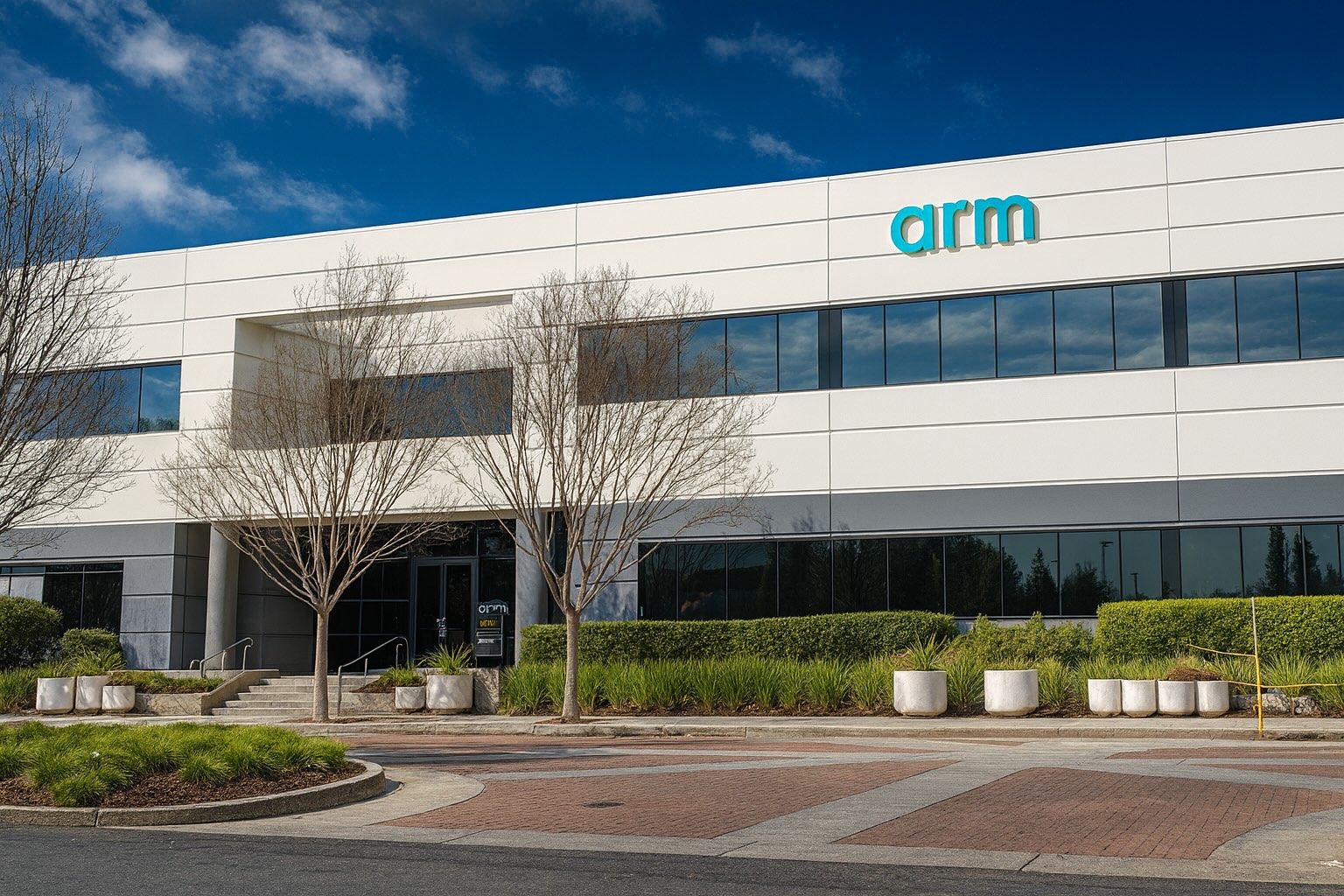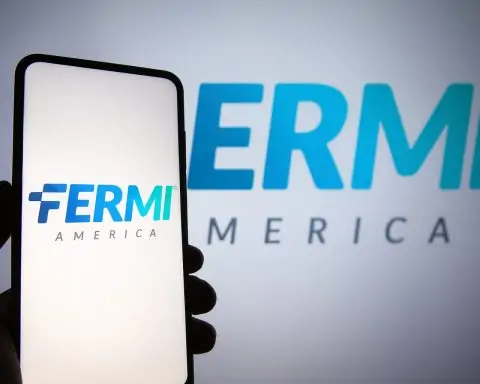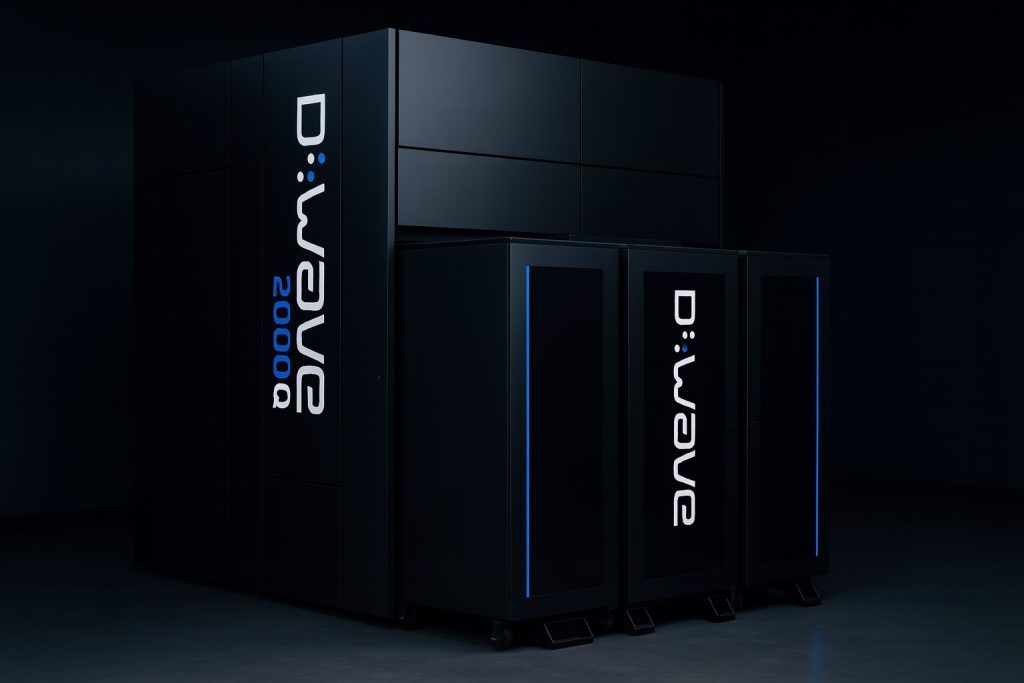- Price & Trend: ARM (NASDAQ: ARM) trades near $155 (Oct 13, 2025) [1], roughly +23% YTD. After briefly spiking near $183 in mid-2025, the stock pulled back into the mid-$150s as recent news drove volatility [2] [3]. Its free float is tiny (~10%, SoftBank keeps ~90%), amplifying moves [4].
- Business Model: UK-based Arm designs (but does not manufacture) chip architectures. Its Cortex CPUs power virtually every smartphone and countless devices [5] [6]. It sells licenses and royalties (e.g. 5% of chip prices for new designs vs 3% for older tech) [7] [8], yielding sky-high gross margins (~97%) [9].
- Ownership & IPO: SoftBank owns ~90% of Arm. The Sept 2023 IPO (at $51 ADS) raised $4.87B for SoftBank (10% float) at a $54.5B valuation [10]. Tech giants (Apple, Google, Nvidia, Samsung, Intel, AMD, etc.) were cornerstone investors in the IPO [11] [12].
- Financials: FY2025 (year ended Mar 2025) revenue ≈$4.0B [13] (first $4B+ year). Q1 FY2026 (Q2 calendar 2025) rev was $1.05B [14]. Smartphone demand remains flat (global smartphone shipments +1% in Q1’26 [15]), but Arm is expanding in servers, automotive, and IoT [16] [17]. Morningstar notes Arm still holds ~99% of smartphone CPU market share [18].
- Competition: Arm faces rising challenges. Open-source RISC‑V is a long-term rival [19], and key customers (Apple, Qualcomm, Nvidia) are also building in-house chips on Arm-based designs [20] [21]. Unlike Nvidia/AMD (which sell chips), Arm’s royalty model gives higher gross margins but may grow slower.
- Valuation & Outlook: At IPO Arm traded ~29× forward EPS [22]; today analysts report it’s trading well above 150× forward earnings (even >200× according to one view) [23], far pricier than peers like Nvidia. Forecasts assume ~20–22% annual rev. growth to ~$8–9B by 2028 [24].
- Recent News: Key events this week include Qualcomm’s adoption of Arm’s v9 CPU architecture for upcoming PC/phone chips [25] [26], Arm’s appeal of a court ruling favoring Qualcomm in a licensing dispute [27], SoftBank arranging a $5B margin loan backed by Arm stock to fund new AI investments [28] [29], and Arm’s unveiling of its new Lumex AI compute platform for devices [30] [31]. These developments have driven recent swings.
Stock Performance and Recent Trends
Arm’s share price has been on a rollercoaster. As of Oct 13, 2025, ARM closed around $154.8 [32]. The stock jumped earlier in October: on Oct 9 it rallied ~5% and on Oct 10 another ~3.7% [33], fueled by news of new product deals. However, it then fell ~9% on Oct 11 [34] as some investors took profits. Overall, ARM is up roughly 23% in 2025 [35], recovering from a swoon in mid-2024. (The 52-week range spans about $80–$183 [36].) Notably, Arm’s public float is very small: SoftBank’s 90% stake means only ~10% of shares trade, so any news can cause outsized moves [37]. For example, after Qualcomm’s Oct 1 announcement (below), ARM stock jumped ~5% intraday [38].
Recent News & Events
SoftBank margin loan: On Oct 10, Reuters/Bloomberg reported that SoftBank is arranging a $5 billion margin loan collateralized by its Arm shares [39]. The proceeds will finance SoftBank’s AI spending (e.g. on OpenAI). Including prior deals, SoftBank’s total loans secured by Arm stock could reach ~$18.5B [40]. This move underscores SoftBank’s strategy of leveraging Arm to fuel growth bets.
Qualcomm partnership: Reuters confirmed (Oct 1) that Qualcomm will use Arm’s latest v9 architecture in its new flagship CPU chips [41]. This decision – announced alongside Qualcomm’s new PC and phone chips – marks a de-escalation in their earlier legal battle. Qualcomm’s adoption of v9 is expected to generate higher royalties for Arm (newer designs carry ~5% royalties) [42] [43]. ARM’s stock jumped on the news, and analysts say the deal reassures investors about Arm’s revenue runway.
Lumex AI platform: On Sept 9, Arm launched “Lumex”, its next-gen mobile CPU family optimized for on-device AI [44]. Lumex chips (built on cutting-edge 3nm processes) are designed to run large AI models locally (e.g. real-time translation, image generation) without cloud support [45] [46]. Arm’s executives say Lumex (part of their Compute Subsystems line) is part of a long-term strategy to boost revenues by targeting AI features in high-end smartphones and wearables [47] [48]. This product launch highlights Arm’s push into AI-capable mobile devices.
Legal update: Arm announced it will appeal a U.S. court ruling from late 2024 that largely favored Qualcomm in their licensing dispute [49]. (Qualcomm had won a jury verdict that its Nuvia CPUs were properly licensed.) Arm says it “remains confident” and is seeking to overturn the judgment [50]. The ongoing litigation poses a headline risk and underscores tensions with a key customer.
Other developments: Arm recently reaffirmed that Q2 FY2026 earnings will be released Nov 5, 2025 (post-market). Analysts expect continued revenue growth driven by AI/5G demand. On Oct 5, Arm announced that network partner Nvidia will build the first “Arm v9-compatible” AI Data Center CPU (Neoverse-based) [51] (since Nvidia acquired Arm’s mid-2023 rival, OpenAI’s backing of Arm). Meanwhile, global trade talks and tariff headlines (e.g. US-China negotiations on Oct 13) are closely watched for semiconductor impact.
Business Model and Fundamentals
Arm operates a royalty/licensing model rather than selling chips. It designs CPU cores and system architectures and licenses these IP blocks to chipmakers and device manufacturers [52]. Customers (from smartphone OEMs to server builders) integrate Arm cores into their own SoCs. This model yields extremely high gross margins (around 97% [53]) because Arm has no fabrication costs. Arm’s revenues come from two main sources: an upfront license fee for each new chip design, and ongoing royalties on each chip sold. Notably, Arm has engineered deals to raise royalties on its newest tech: for example, the v9 architecture carries a 5% royalty rate, versus 3% on older versions [54].
According to official filings, Arm’s FY2025 (ended Mar 2025) revenue was roughly $4.0 billion [55] (first year above $4B). For Q1 FY2026 (Jun 2025), Arm reported $1.05B in sales [56] (slightly above forecasts). About half of revenue comes from licensing and half from royalties. Key customers include all major smartphone SoC vendors – its technology underpins Qualcomm’s Snapdragon, Apple’s A/M chips, Samsung Exynos, and many others [57]. Arm now also has thousands of designs in data center CPUs (Neoverse) and advanced accelerators, and its IP appears in IoT devices and automotive chips.
Profitability is very high: gross margin is typically ~97% [58]. Reported operating margins (non-GAAP) have been in the ~30–40% range recently, though rising R&D and SG&A (for new initiatives like chip development) have weighed on op income. For example, an analysis notes rising costs have pushed Arm’s operating margin “down into the teens” [59]. Net profit margin (annual) is roughly 20% (Reuters data show ~19.8% TTM) [60]. Arm is practically debt-free (outside SoftBank financing), and its royalty streams create strong cash flow.
Management has guided conservatively. In Feb 2025 (Q3 FY2025 results), Arm narrowed full-year guidance to ~$3.94–4.04B (midpoint ~$3.99B) [61], citing visibility near year-end. This was slightly below some analyst expectations. For Q2 FY2026 (current quarter), management guided revenue ~$1.01–1.11B [62] (midpoint $1.06B), roughly in line with consensus. The overall tone is cautious: President Trump’s tariffs and slowing phone sales are cited as headwinds [63] [64].
Market Position and Competition
Arm is the de facto standard architecture for mobile and edge devices. Industry data and analysts agree: Arm-based chips account for roughly 99% of smartphone CPUs [65] and dominate tablets, embedded systems, and IoT endpoints. Its CPU cores are lauded for power efficiency, which is vital in battery-powered devices. This breadth has led to Arm being called the “Switzerland of semiconductors” for licensing to even rivals [66].
However, Arm faces growing competition:
- In open-source architectures: RISC-V (an open instruction set) is cited by analysts as a challenge, but it’s still far behind Arm in maturity and ecosystem [67] [68]. Many start-ups use RISC-V, but it has a smaller developer base.
- In-house chips: Major customers are increasingly designing their own chips using Arm’s instruction set (e.g. Apple’s M-series, AWS’s Graviton, Meta’s chips, and NVIDIA’s forthcoming Grace CPU). Qualcomm and MediaTek remain loyal but also develop customized Arm-based SoCs. Arm’s attempt to raise royalties has caused friction (e.g. the Qualcomm dispute) [69] [70]. If a customer ever switched to RISC-V or another architecture, it could dent royalties.
- AI-centric rivals: Companies like Nvidia, Intel, and AMD directly sell AI hardware. Nvidia (USD share) is the AI chip leader, and AMD/Intel are pushing AI CPUs/accelerators. These rivals have much higher R&D spending and (currently) faster growth. Arm’s licensing model is more indirect: it participates in the AI boom by licensing designs (e.g. ARM IP in AWS’s AI chips, in the new Qualcomm v9 chips, and in custom data center designs), but it doesn’t sell the chips themselves. As one analysis notes, Arm’s high gross margin “comes with a caveat: rising costs have dragged operating margins down into the teens, far below the likes of Nvidia” [71].
Geopolitics is also a factor: Arm’s designs are globally ubiquitous, but the company must navigate U.S.-China tech tensions (e.g. export controls on semiconductors) and potentially diversify beyond any single country. Recent inclusion in the U.S. “Stargate” AI infrastructure project (with SoftBank, Oracle, and Arm as participants) highlights its strategic role [72].
Financial Outlook and Analyst Views
Analysts remain bullish on Arm’s long-term growth but caution on valuation. Consensus forecasts (pre-news) envisioned ~20–22% annual revenue growth through 2028. For example, Simply Wall Street notes Arm’s forecasts imply hitting ~$7.4 billion revenue and $2.3 billion earnings by 2028 under a ~21.5% growth rate [73]. Others (including some at Wall Street) are slightly more optimistic, projecting ~$8–9B by late decade if AI adoption accelerates. However, forecasts vary widely: some bull-case analysts assumed much higher growth if Arm cracks data-center and automotive, while bears worry about smartphone saturation and legal battles [74] [75].
Technically, the stock is considered overbought by some. It has recently consolidated in the $150–160 range. Short-term analysts point to the near-term catalyst of the upcoming Q2 FY2026 earnings (Nov 5, 2025) – expected to reflect continued royalty gains but possibly muted smartphone demand. Long-term investors focus on macro trends: growth of AI at the edge, 5G expansion, and autonomous vehicles (all areas where Arm is partnering with chipset makers) could drive revenues.
Competitive comparisons: By P/E ratio, Arm is priced much higher than Nvidia (which trades ~60–70× forward EPS) [76]. Morningstar and others note that Arm’s extremely high P/E reflects expectations of a sustained AI-driven growth cycle. If that cycle slows, the stock could be vulnerable to a correction. Conversely, success of initiatives like Neoverse for data centers, Lumex for mobile AI, and higher royalty renewals (like raising royalties on next-gen chips) could justify the premium.
Recent analyst actions: Many firms have issued buy/hold ratings, though a few have cautioned (some even lowered targets after legal news). The American Assoc. of Individual Investors noted (Sept 2025) that Arm has had significantly more downgrades than upgrades recently, citing valuation concerns [77].
Strategic Partnerships and AI Leadership
Arm’s value lies in its ecosystem and partnerships. It boasts alliances with virtually every major chipset and device maker: Apple, Samsung, MediaTek, Qualcomm, Google (Tensor), and many more license Arm cores. In AI and data centers, Arm’s Neoverse CPUs and ML accelerators (like the Ethos series) power growing infrastructure (e.g. AWS’s and Azure’s Arm-based servers). Arm even joined the U.S. trillion-dollar “Project Stargate” AI data-center initiative with SoftBank and Oracle [78], underscoring its strategic role.
On the device side, Arm is actively courting 5G/AI handset makers. Its new Lumex designs (Sept 2025) are aimed at next-gen phones and wearables, and its existing ‘CSS’ (Compute Subsystem) business provides turnkey chip designs. Arm also pushes into automotive: it claims products that enable AI-driven vehicles (70% of the world’s population relies on Arm tech, per CEO Rene Haas) [79]. Partnerships like Arm-based chips in Tesla (Nvidia/Arm collaboration in the Drive platform) and upcoming deals with automakers highlight this trend.
Importantly, Arm’s customers themselves invest in Arm’s success: Beyond IPO cornerstone investors, companies like Nvidia (via its recent acquisition of Arm’s Midjourney competitor) and Samsung (its own foundry and device maker) continue deep technical ties. Arm also develops software tools (via its ecosystem of 22 million developers) to keep its architecture attractive.
Expert Commentary & Analysis
Industry analysts are broadly positive on Arm’s prospects, though caution on valuation. As one fund manager put it at the IPO, “It is a successful IPO… shows the AI theme is alive and kicking,” reflecting confidence in Arm’s AI positioning [80]. After Q1 FY2026 results, Summit Insights’ Kinngai Chan commented: “Results and outlook were light and below expectations,” noting weak smartphone demand, which sent shares down [81]. Conversely, Running Point Capital’s Michael Schulman observed that “smartphone royalties remain soft… but cloud‑server and AI accelerator design wins keep the (next gen) royalty treadmill humming,” highlighting Arm’s growth levers [82].
Some market analysts have raised concerns. An October InvestorsObserver analysis notes that “ARM trades at more than 200 times earnings”, implying sky-high growth baked in [83]. It pointed out that about 45% of royalties still come from smartphones, a mature market [84], leaving little room for surprise. The same commentary warned that if Arm’s strategy to make chips materializes, it could even alienate customers [85]. Another strategist remarked that Arm’s new direction (exploring finished chips and chiplets) is a “U-turn” from its pure licensing roots and brings execution risk [86] [87].
On the other hand, many analysts emphasize Arm’s irreplaceable role in the semiconductor ecosystem. Reuters quoted Salman Malik (Anson Funds) calling Arm’s IPO “a successful IPO… the AI theme is alive and kicking” [88], and others note that armoring Arm with AI features (like Neoverse and Lumex) could sustain long-term royalty growth. In comparing peers, some analysts say Arm’s model is more stable but slower-growing than Nvidia’s chip sales; for example, one analysis quipped “ARM is priced like an emerging AI juggernaut but looks more like a mature business chained to slow-growth markets” [89].
Investors are divided: bulls cite Arm’s command over nearly every handset and its new role in AI endpoints as secular tailwinds; bears cite the stretched valuation and legal uncertainties. As of mid-Oct, sentiment seems cautiously optimistic. Arm’s near-term stock moves will likely hinge on earnings feedback (Nov 5 call) and any softening or strengthening of the AI and smartphone markets. In the longer run, Arm’s unique licensing model, broad customer base, and new AI-focused products give it a strong franchise – if it can justify the high multiples the market is paying [90] [91].
Sources: Official filings and press releases [92] [93]; Reuters (stock performance, financials, news events) [94] [95] [96] [97] [98]; TS2.tech analysis [99] [100]; Simply Wall St / SahmCapital analysis [101] [102]; Investor commentary (Analysts’ quotes) [103] [104] [105] [106] [107]. All data are as of mid-October 2025.
References
1. www.reuters.com, 2. www.reuters.com, 3. www.intelligentinvestor.com.au, 4. ts2.tech, 5. ts2.tech, 6. ts2.tech, 7. ts2.tech, 8. ts2.tech, 9. investorsobserver.com, 10. ts2.tech, 11. ts2.tech, 12. ts2.tech, 13. www.reuters.com, 14. www.reuters.com, 15. www.reuters.com, 16. ts2.tech, 17. www.reuters.com, 18. www.reuters.com, 19. www.reuters.com, 20. ts2.tech, 21. www.reuters.com, 22. ts2.tech, 23. investorsobserver.com, 24. simplywall.st, 25. www.reuters.com, 26. www.sahmcapital.com, 27. www.reuters.com, 28. www.reuters.com, 29. finimize.com, 30. www.reuters.com, 31. www.sahmcapital.com, 32. www.reuters.com, 33. www.intelligentinvestor.com.au, 34. www.intelligentinvestor.com.au, 35. www.reuters.com, 36. www.reuters.com, 37. ts2.tech, 38. www.reuters.com, 39. www.reuters.com, 40. finimize.com, 41. www.reuters.com, 42. www.reuters.com, 43. www.sahmcapital.com, 44. www.reuters.com, 45. www.reuters.com, 46. www.reuters.com, 47. www.reuters.com, 48. www.reuters.com, 49. www.reuters.com, 50. www.reuters.com, 51. www.reuters.com, 52. ts2.tech, 53. investorsobserver.com, 54. ts2.tech, 55. www.reuters.com, 56. www.reuters.com, 57. ts2.tech, 58. investorsobserver.com, 59. investorsobserver.com, 60. www.reuters.com, 61. www.reuters.com, 62. www.reuters.com, 63. www.reuters.com, 64. www.reuters.com, 65. www.reuters.com, 66. ts2.tech, 67. www.reuters.com, 68. ts2.tech, 69. www.reuters.com, 70. www.reuters.com, 71. investorsobserver.com, 72. www.reuters.com, 73. simplywall.st, 74. www.sahmcapital.com, 75. investorsobserver.com, 76. investorsobserver.com, 77. investorsobserver.com, 78. www.reuters.com, 79. ts2.tech, 80. ts2.tech, 81. www.reuters.com, 82. www.reuters.com, 83. investorsobserver.com, 84. investorsobserver.com, 85. investorsobserver.com, 86. www.reuters.com, 87. investorsobserver.com, 88. ts2.tech, 89. investorsobserver.com, 90. investorsobserver.com, 91. www.reuters.com, 92. newsroom.arm.com, 93. www.reuters.com, 94. www.reuters.com, 95. www.reuters.com, 96. www.reuters.com, 97. www.reuters.com, 98. www.reuters.com, 99. ts2.tech, 100. ts2.tech, 101. www.sahmcapital.com, 102. www.sahmcapital.com, 103. ts2.tech, 104. www.reuters.com, 105. www.reuters.com, 106. investorsobserver.com, 107. investorsobserver.com







